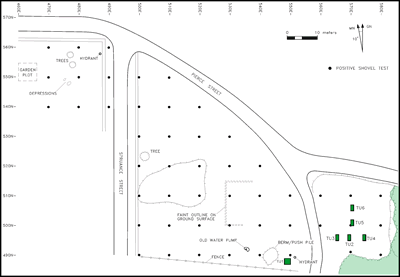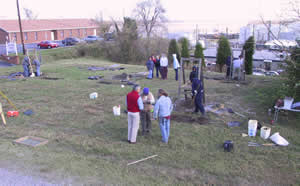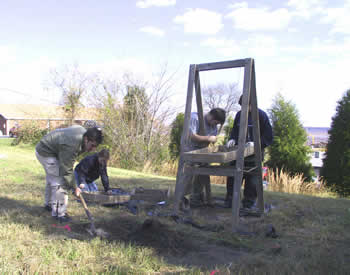Pierce Street Lot
 Test excavations were carried out at the Pierce Street lot in City Point that had been surveyed during the summer of 2002. We were drawn back to this location in search of early colonial settlement dating from the 1600s. A single pipe fragment characteristic of this period was found by last summer's survey, indicating that this property held some potential for an early English site. The results of this year's testing did not disappoint us.
Test excavations were carried out at the Pierce Street lot in City Point that had been surveyed during the summer of 2002. We were drawn back to this location in search of early colonial settlement dating from the 1600s. A single pipe fragment characteristic of this period was found by last summer's survey, indicating that this property held some potential for an early English site. The results of this year's testing did not disappoint us.
Photo right: During the 2002 fieldwork, shovel tests (represented by black dots) on this city-owned property had yielded hints of an early colonial presence. To further explore this possibility, we excavated Test Unit 1 in the southeast corner of the middle lot. Distinctive locally made tobacco pipes in this unit confirmed our expectations of 17th century occupation. With the help of students from Rocky Mount Preparatory School, we opened another five test units in the southeastern lot. This productive session of volunteer digging revealed relatively undisturbed soil layers, with artifacts generally increasing in age with depth.
The first two units we excavated produced a variety of artifacts, ranging from prehistoric Indian pottery to modern toys. But mixed with this material were several fragments of telltale 17th-century pipes. With them were also some small pieces of early colonial ceramics and glass.
Encouraged by these results, we returned again a few weeks later to open four more test units. This work was carried out with the help of about a dozen high school students from Rocky Mount Preparatory School in North Carolina. These hard-working and enthusiastic students generated a wealth of new and useful information. Most importantly their findings substantiate the indications of early English occupation. More pipe fragments were found along with all manner of other artifacts from several periods.

Photo left: Test units on the Pierce Street property yielded fragments of locally made 'Chesapeake' tobacco pipes with distinctive incised decoration. The pipes and other artifacts indicate the presence of English settlers at least as early as the mid-17th century.
Here, too, the results of this year's work are still under analysis. However, it is certain that this spot was chosen for European settlement by the mid-17th century. We can only speculate that it was the site of a small tobacco "plantation." Future work will probably reveal features in the ground that define where a dwelling stood and other activities were carried out.
Eleventh grade students from the Rocky Mount Preparatory School in North Carolina had been well prepared for the Pierce Street dig by their teacher Jill Foster. The result was a rich hands-on learning experience for the students and a much appreciated, substantial contribution to this year's field effort. Twelve students and six archaeologists from William & Mary excavated five 1 x 2 meter (3.3 x 6.6 feet) test units, a useful sample from this promising site.
Photos below: Pierce Street Lot excavations

















